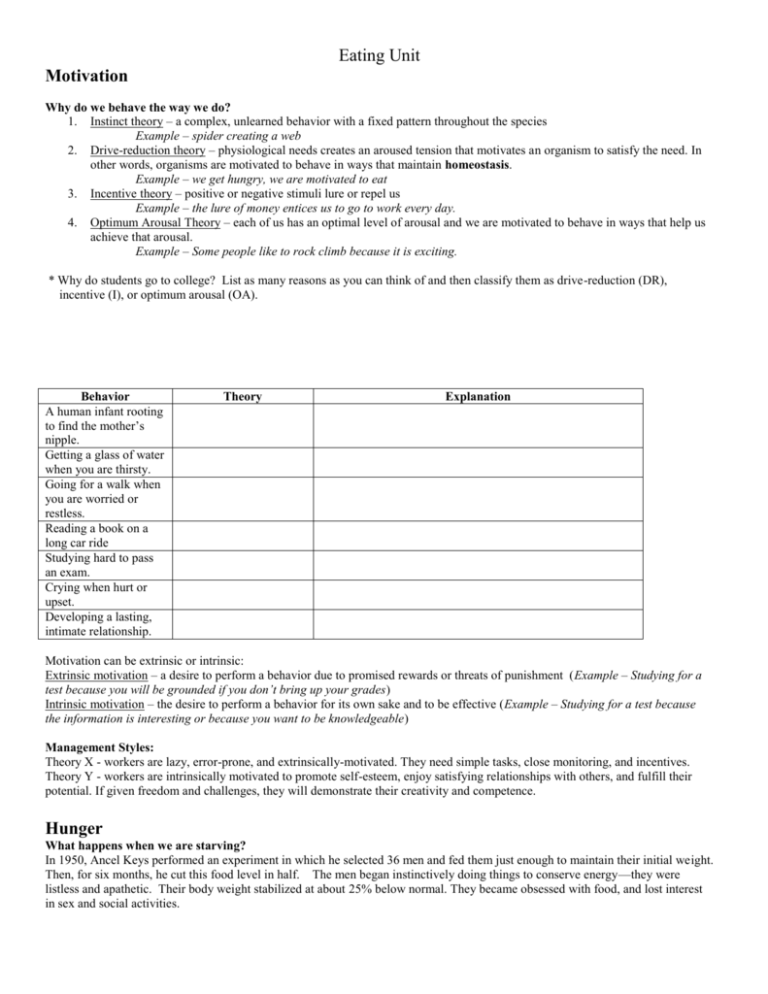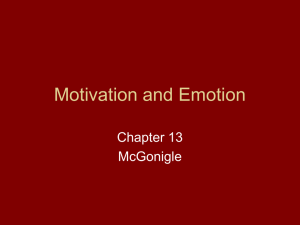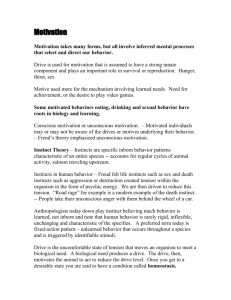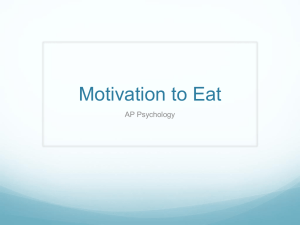Motivation pp
advertisement

Eating Unit Motivation Why do we behave the way we do? 1. Instinct theory – a complex, unlearned behavior with a fixed pattern throughout the species Example – spider creating a web 2. Drive-reduction theory – physiological needs creates an aroused tension that motivates an organism to satisfy the need. In other words, organisms are motivated to behave in ways that maintain homeostasis. Example – we get hungry, we are motivated to eat 3. Incentive theory – positive or negative stimuli lure or repel us Example – the lure of money entices us to go to work every day. 4. Optimum Arousal Theory – each of us has an optimal level of arousal and we are motivated to behave in ways that help us achieve that arousal. Example – Some people like to rock climb because it is exciting. * Why do students go to college? List as many reasons as you can think of and then classify them as drive-reduction (DR), incentive (I), or optimum arousal (OA). Behavior A human infant rooting to find the mother’s nipple. Getting a glass of water when you are thirsty. Going for a walk when you are worried or restless. Reading a book on a long car ride Studying hard to pass an exam. Crying when hurt or upset. Developing a lasting, intimate relationship. Theory Explanation Motivation can be extrinsic or intrinsic: Extrinsic motivation – a desire to perform a behavior due to promised rewards or threats of punishment (Example – Studying for a test because you will be grounded if you don’t bring up your grades) Intrinsic motivation – the desire to perform a behavior for its own sake and to be effective (Example – Studying for a test because the information is interesting or because you want to be knowledgeable) Management Styles: Theory X - workers are lazy, error-prone, and extrinsically-motivated. They need simple tasks, close monitoring, and incentives. Theory Y - workers are intrinsically motivated to promote self-esteem, enjoy satisfying relationships with others, and fulfill their potential. If given freedom and challenges, they will demonstrate their creativity and competence. Hunger What happens when we are starving? In 1950, Ancel Keys performed an experiment in which he selected 36 men and fed them just enough to maintain their initial weight. Then, for six months, he cut this food level in half. The men began instinctively doing things to conserve energy—they were listless and apathetic. Their body weight stabilized at about 25% below normal. They became obsessed with food, and lost interest in sex and social activities. Eating Unit The Physiology of Hunger Stomach fullness When stomach muscles are stretched (stomach is full), a message is sent to brain to inhibit further eating. Body Chemistry – chemicals in our body affect our desire to eat Glucose – when blood glucose drops, we feel hungry Insulin – an increase in insulin causes a drop in blood glucose. Thus, we feel hungry when insulin increases. Leptin – hormone secreted by bloated fat cells that decreases hunger and increases activity (leptin lowers hunger) Neuropeptide Y – hormone secreted by the hypothalamus that increases drive to eat (particularly carbohydrates) Ghrelin – hormone secreted by organs of the digestive tract that stimulates appetite. Cholecystokinin (CCK) – a hormone secreted as the food enters the small intestine from the stomach that suppresses appetite. In some bulimics, CCK release is inhibited, thus accounting for binge-eating. Norepinephrine – a hormone that triggers the fight-or-flight response, leading to suppression of appetite. Orexin – a hormone secreted by the hypothalamus that increases hunger. Serotonin – Serotonin is derived from carbohydrates in your diet. When serotonin levels are low (as in depression), your hunger increases (especially for carbohydrates). Some people believe that our cravings for sweet foods (carbs) following disappointment is an attempt to raise serotonin levels and make ourselves feel better. For some people, antidepressants such as SSRI’s, which raise serotonin levels, diminishes their urge to overeat. Fill in the summary chart with the information above: Suppress Appetite Stimulate Appetite The Brain – Brain structures play a role in our desire to eat Hypothalamus - controls drive to eat – - Lateral hypothalamus (sides of hypothalamus) – stimulation increases drive to eat o Destruction of LH causes rats to have no interest in food, even when starving - Ventromedial hypothalamus (lower middle part) – stimulation decreases hunger. o Destruction of VMH causes rats to 1) eat more and 2) metabolize food more efficiently. This combination leads to a very fat mouse. * Memory Aid “V” looks like an arrow pointing down. Stimulation of ventromedial hypothalamus DECREASES hunger. Set-point theory Set point – the point at which an individual’s “weigh thermostat” is supposedly set. When weight goes above set point, biological pressures act to decrease hunger and increase metabolism. When weight drops below set point, biological pressures act to increase hunger and decrease metabolism. This is why most people loss weight on a diet quickly at first, but then further weight loss occurs very slowly. Our set point is determined both by genetics and body composition. Fat cells are much more efficient with food than muscle cells, and therefore, people with little muscle find that their bodies do not burn food as easily. This is why exercise (which increases muscle mass) is necessary for a diet to be successful. Without exercise, our set point remains the same and our body resists weight loss. Unfortunately, once we have accumulated fat, it is very hard to get rid of it. 1. Fat cells shrink during dieting, but do not disappear. 2. Fat cells have low metabolic rates and require less food to maintain than other types of tissue. Genetics - Underlying many of the physiological aspects of hunger is genetics. - Twin and adoption studies confirm that body weight is partially genetic. Eating Unit The Psychology of Hunger Obesity is increasing in developed countries all over the world. This cannot be explained by genetics. External Cues – 1) Overweight people are more likely to respond to external cues to eat rather than internal cues (signals from body that we are hungry) 2) External cues include: availability of food, time schedules for eating, eating out of habit, eating when bored or stressed, eating because others are eating. 3) External cues can affect our body chemistry. Insulin levels actually increase at the sight and smell of delicious food. Taste Preference – 1) Carbohydrates increase serotonin levels, making us feel calm. 2) Preference for fat, sweet, and salty foods are genetic and universal 3) We naturally dislike foods that are unfamiliar (probably an adaptive strategy to avoid toxic substances) Learning – 1. We learn to like foods associated with pleasant social interaction 2. We learn to dislike foods coupled with nausea or vomiting (conditioned taste aversion) 3. We learn when to eat. Memory of our last meal affects our desire to eat (if we remember that we just ate, we don’t feel hungry) 4. We are more likely to enjoy a new food if we observe others enjoying it Obesity and Weight Control Dangers of obesity: 1. Physical – increased risk of diabetes high blood pressure, heart disease, gallstones, arthritis, sleeping disorders 2. Psychological – people tend to stereotype obese people as slow, lazy, and sloppy; victims of ridicule and job discrimination. Hints for Losing Weight 1. 2. 3. 4. 5. 6. Minimize exposure to external food cues. Exercise to boost your metabolism. Set realistic goals. Change the type of food you eat – eat less fat and sugar Don’t starve yourself all day and eat one big meal at night If you have a lapse on your diet, don’t assume that you’ve blown it for good and binge. Eating Disorders Anorexia nervosa – intense fear of gaining weight disturbed body image, refusal to maintain normal body weight (15% or more below normal), and dangerous measures to lose weight; Often do not realize their eating behavior is pathological and often refuse treatment Associated medical problems: 1. lack of menstrual periods (amenorrhea) 7. dizziness and headaches 2. lack of energy 8. lanugo (fine hair growth) 3. feeling cold all the time 9. low blood pressure 4. dry, yellowish skin 10. osteoporosis 5. constipation 11. cardiac arrest (2-10% die from disease) 6. insomnia or restlessness Bulimia nervosa – habitually engaging in overeating followed by unhealthy compensatory efforts such as self-induced vomiting, fasting, abuse of laxatives, or excessive exercise; easier to hide than anorexia because 1) they don’t avoid food completely and 2) weight fluctuates around normal range; patients suffer intense guilt and usually recognize that their eating behavior is pathological. Associated medical problems 1. Bloating or swelling of 4. Chronic sore throat 8. Constipation hands and feet 5. Acid reflux 9. Cardiac arrhythmias 2. Dizziness 6. Swollen cheek and salivary 10. Metabolic deficiencies 3. Tooth decay and mouth glands sores 7. Ruptured stomach Eating Unit Factors that contribute to development of an eating disorder Personality - People with anorexia are often perfectionists and overachievers. They’re the “good” daughters and sons who do what they’re told, excel in everything they do, and focus on pleasing others. But while anorexics may appear to have it all together on the surface, inside they feel helpless, inadequate, and worthless. They view themselves through a harshly critical lens. If they’re not perfect, they’re a total failure. Genetics – Twin studies suggest that a genetic predisposition to anorexia may run in families. Brain chemistry also appears to play a significant role. People with anorexia tend to have high levels of cortisol, the brain hormone most related to stress, and decreased levels of serotonin and norepinephrine, which are associated with feelings of well-being. Family and Social Pressure - In addition to the cultural pressure to be thin, there are other family and social pressures that can contribute to anorexia. This includes participation in an activity that demands slenderness, such as ballet, gymnastics, or modeling. It also includes having parents who are overly controlling, put a lot of emphasis on looks, diet themselves, or criticize their children’s bodies and appearance. Stressful life events—such as the onset of puberty, a breakup, or going away to school—can also trigger anorexia. Have standards of thinness really increased? - Most models and actresses have a little over ½ the body fat of the average woman. - Since 1950, department-store mannequins have lost 3 inches around their hips. Women with as little body as today’s mannequins would not menstruate. - Miss America contestants weigh about 15 lbs less than those 40 years ago. Playboy centerfolds have shown a greater change in weight over the same period of time. Cultural pressure to be thin correlates positively with body dissatisfaction and incidence of eating disorders. - A study at St. George's Hospital Medical School in London revealed that when asked to estimate the width of a box, 50 average-size women were right on target. But when asked to estimate their body widths, they exaggerated the size of their waists by about 25% and their hips by about 16%. - Eating disorders are much more common in females in weight-conscious cultures. - As standards for thinness have increased, so have incidence of eating disorders. Stress Stress is the process by which we appraise and cope with environmental threats and challenges. General Adaptation Syndrome (GAS) -- a nonspecific process by which our body responds to stress Phase 1: Alarm reaction – sudden activation of sympathetic nervous system; release of adrenaline and noradrenaline increase heart rate and respiration, diversion blood from digestion to skeletal muscles, dulling of pain, and release sugar in the blood. Phase 2: Resistance – if stressor remains for a long time, we enter the resistance phases. During this phase, temperature, blood pressure, and respiration remain high (but not as high as original phase) due to the release of the hormone, cortisol. Phase 3: Exhaustion – If stressor continues over a substantial period of time, we enter the exhaustion stage. During this stage the body becomes depleted of reserves. Prolonged exposure to stress can lead to shrinking of the hippocampus, hypertension, susceptibility to diabetes and ulcers, and reduced immune functioning. * Check your understanding of the effects of various factors that influence hunger by indicating whether hunger would tend to increase (I) or decrease (D) in each of the situations described below. ____1. The ventromedial hypothalamus of a rat’s brain is destroyed by lesioning. ____2. The glucose level in Marlene’s bloodstream decreases. ____3. Norman, who is not diabetic, receives an injection of insulin. ____4. You’re watch has broken, but the clock on the wall says its an hour past your usual dinnertime. ____5. Brownies are baking in the oven and the smell permeates the house. ____6. A rat is given an injection of leptin. ____7. A rat is given an injection of neuropeptide Y.








